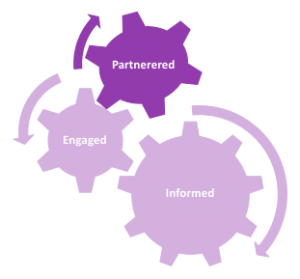PART 3 – The Life Of The Party: Everything You Need To Know About Managing Your Client
15 Chapter 15: Keep Your Client Partnered
 Many students who have come before you have had great difficulty navigating through situations that involve clients with very strong or different opinions. It becomes even trickier when there is a high degree of politics or infighting on the client side. And when the slightest bit of conflict between student teams and clients starts to simmer, students tend to just awkwardly freeze in their tracks, hoping that by a miracle, they’re suddenly invisible.
Many students who have come before you have had great difficulty navigating through situations that involve clients with very strong or different opinions. It becomes even trickier when there is a high degree of politics or infighting on the client side. And when the slightest bit of conflict between student teams and clients starts to simmer, students tend to just awkwardly freeze in their tracks, hoping that by a miracle, they’re suddenly invisible.
Like that time your client says to you, “I know we’re already 5 months into this billing automation project, but the President has heard that the Marketing department has been up to some really great things and she feels that’s where the money’s at. Can you read through the social media analytics report tomorrow?”.

Fortunately, if you’ve read through Chapters 13 and 14, much of the same advice applies here too in keeping your client partnered with you. Though there are just a few more things to consider when navigating through your business relationship.
Scope Creep
As with keeping the client engaged, being partnered comes down to keeping communication channels open and ensuring you start with solid guidelines and boundaries. If there’s the slightest hint of scope creep, you can always refer back to your project contract to help redirect the project back on course. That’s why it’s important to ask yourself if there are any grey areas or anything open for interpretation when going through the contract creation process with your client. You want to have clear perimeters around your project so don’t be afraid to ask questions throughout your project.
ACTIVITY
Even though everyone has the same instructions and the same starting materials, oftentimes each person yields a different result due to interpretations and assumptions. As an example, round up your team to do the following activity. Each of you will need a letter size sheet of paper.
A similar activity with written instructions can be found here.
Embracing Change and Ambiguity
That being said, it’s good business for you to also remain flexible. If a reasonable adjustment is needed to best meet business objectives and provided that it still allows you to meet your objectives, then be open to making changes where there are business needs. Businesses are always changing. As long as the change to scope provides value to the client and won’t throw your team off course, don’t be shy to fill out a change request (CR) form and take on the changes (see Part 5 for templates and samples). If it’s going to completely change your project and compromise what you promised to deliver, then point the client back to your project contract.
SIDE NOTE
A story about change:
The Capstone project was focused on the security training process for an insurance company. It was the understanding of the team that they would identify a training solution and write user documentation. However, they did not clearly define what was entailed in their project work. When the winter semester came along, the Capstone team were taken aback when they were told that they were also expected to implement the solution as well as supply documentation for user, system admin, and security configuration. Due to the time constraints, the team could not complete all of the documentation, and the client sternly pointed out that the team breached the contract! Had the team clearly defined the project deliverables, they would have avoided being in a sticky situation and the embarrassment of receiving criticism from the client.
SIDE NOTE
A story about ambiguity:
A group of six was working for a client who was very eager to work on the Capstone project. The client, in his excitement, assigned six employees to work with the Capstone team and instructed them to divide the group into three subgroups, each of which focused on improving a different part of the system they were using including HelpDesk, Digital Media, and Infrastructure. The students were excited and confused at the same time; they weren’t really sure of the direction they were heading towards. Yet, every time the Capstone team met with their instructor, the update would simply be, “Everything’s going great!”.
It wasn’t until the instructor received the team’s deliverables that gap was discovered. There was a great lack in definition of the process the team needed to improve on and, relenting, the group bashfully admitted that they did not exactly know what the process of the focus was in their Capstone project. In lifesaver mode, the instructor had to reach out to the client, and only after several rounds of discussion were both sides finally able to reach an agreement. However, by that time, it was almost November, and the due date for the interim report was merely three weeks away.
Dealing with Conflict
Conflict \ˈkän-ˌflikt \ noun – Competitive or opposing action of incompatibles : mental struggle resulting from incompatible or opposing needs, drives, wishes, or external or internal demands.[1]
When conflict does arise with your client, don’t be shy or argumentative. This isn’t about fight or flight. There’s a professional way to deal with disagreements. First, remember that your client is human too. Give others the benefit of the doubt and believe that they are acting with the best of intentions. If you notice that something is off or your client seems upset, talk it through with honestly. Don’t let the situation stew because you’re afraid to come up against any sort of differences. Take the lead on resolving issues and misunderstandings. Doing this in a timely manner will not only win you favour with the client, but it’ll also improve your relationship. Believe it or not, research has shown that those, “who address and resolve their conflicts are significantly more satisfied with their relationships than [partners] who do not”.[2]
When it comes to being partnered, don’t overlook your team either. Clients can sense when team dynamics are off. Is one of your teammates not pulling their weight? Did someone on your team completely talk all over you during a client meeting? Have you had a blowout with a group member on the information they included in their written part? Your team members needs to be partnered with each other first before you can expect the client to dap fists with you.
Advice from an Expert
The advise doesn’t stop there. Tamara Doerksen, Director of ITS at KPMG and Founder/CEO of Lonny’s Smile Foundation, with her wealth of experience offers a few more tips:
- Have a solid foundation. Project contract that outlines what communications and expectations are and how you’ll engage with each other
- Ask for feedback. You will be able to course correct along the way.
- It’s a 50/50 relationship. Partnership means an equal relationship. Present yourself in a way that the client looks at you like a professional, not a student.
- Name it and claim it. Check out this podcast on saving your client relationship.
- Have fun with your project. The Capstone project is the crowning glory of your undergraduate education!
- Conflict. (n.d.). Retrieved May 4, 2018, from https://www.merriam-webster.com/dictionary/conflict ↵
- Owens, M. (2015, October 29). The Art of Confrontation: How Conflict Can Improve a Feeler’s Relationships. Retrieved from https://www.truity.com/blog/art-confrontation-how-conflict-can-improve-feeler%E2%80%99s-relationships ↵


Feedback/Errata